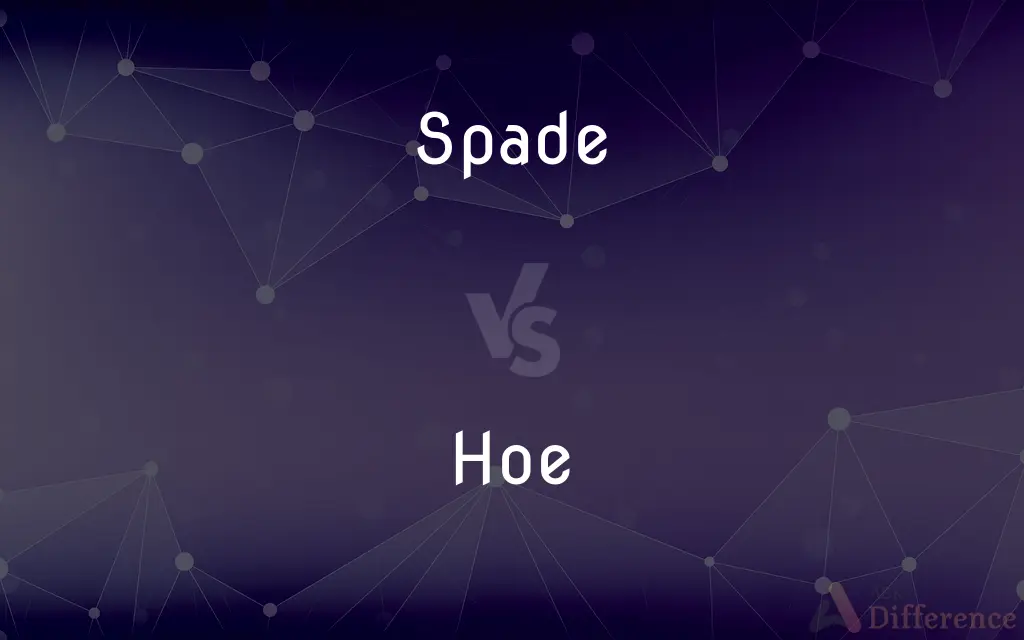Spade vs. Hoe — What's the Difference?
By Fiza Rafique & Urooj Arif — Updated on March 3, 2024
A spade is primarily used for digging and slicing through soil, featuring a flat, sharp-edged metal blade, while a hoe is designed for shaping soil, removing weeds, and harvesting root crops, with a long-handled tool ending in a thin, flat blade.

Difference Between Spade and Hoe
Table of Contents
ADVERTISEMENT
Key Differences
A spade is a garden tool with a sharp, flat blade, used for cutting into the earth and lifting soil, making it ideal for tasks like digging holes or edging garden beds. Whereas a hoe, with its flat blade at a right angle to the handle, is more suited for agitating the surface of the soil, weeding, and creating furrows for planting seeds.
Spades are typically made with a shorter handle and a flat, rectangular blade, which allows for more precise control when digging or slicing through tough soil. On the other hand, hoes come in various shapes and sizes, including the common garden hoe with a square blade and the Dutch or stirrup hoe with a looped blade, each designed for specific types of weeding and soil cultivation tasks.
The design of a spade facilitates the removal of soil or sod with minimal effort, its sharp edge easily cutting through the ground. Hoes, however, are designed to skim the surface of the soil, cutting weeds at their base and disturbing the soil just enough to hinder weed growth without significant digging.
When it comes to planting, spades are often used to prepare the ground by creating holes or trenches for seeds or plants, providing a clear, well-defined space. A hoe, while it can be used to create shallow trenches for seeds, is primarily employed for maintaining the soil around plants, including weeding and aerating the ground.
Spades usually have a D-shaped handle that offers comfort and control during the digging process, making it easier to apply force vertically. In contrast, hoes are equipped with longer handles, allowing the user to work while standing up straight, reducing back strain during repetitive motions such as weeding.
ADVERTISEMENT
Comparison Chart
Primary Use
Digging and slicing through soil
Shaping soil, removing weeds, harvesting
Blade Shape
Flat, sharp-edged metal blade
Thin, flat blade set at a right angle
Handle Length
Shorter for precision
Longer for upright use
Ergonomics
D-shaped handle for control
Long handle to reduce back strain
Functionality
Ideal for cutting into earth and lifting soil
Suited for agitating soil and weeding
Compare with Definitions
Spade
Often used in garden bed preparation.
She wielded her spade to edge the garden beds meticulously.
Hoe
Designed for surface soil agitation.
With swift movements, she used the hoe to aerate the soil around the plants.
Spade
Ideal for precise digging work.
They selected a spade for the precision required in transplanting the flowers.
Hoe
A long-handled tool with a thin, flat blade for weeding and soil shaping.
He used a hoe to remove weeds from the vegetable garden.
Spade
A tool for digging, having a sharp-edged, rectangular metal blade and a long handle.
He used a spade to dig a hole for the new tree.
Hoe
Enhances soil health by aerating and weeding.
Regular hoeing kept the garden beds free of weeds and the soil well-aerated.
Spade
Designed for slicing through tough soil.
The gardener's spade easily cut through the compacted earth.
Hoe
Varied designs for specific tasks.
The Dutch hoe proved effective for slicing through weed roots with ease.
Spade
Suitable for lifting and moving soil.
With a spade, he lifted the loosened soil out of the garden plot.
Hoe
Useful in creating furrows for planting.
They employed a hoe to make shallow trenches for the seeds.
Spade
A spade is a tool primarily for digging, comprising a blade – typically stunted and less curved than that of a shovel – and a long handle. Early spades were made of riven wood or of animal bones (often shoulder blades).
Hoe
A tool with a flat blade attached approximately at a right angle to a long handle, used for weeding, cultivating, and gardening.
Spade
A sturdy digging tool having a thick handle and a heavy, flat blade that can be pressed into the ground with the foot.
Hoe
To weed, cultivate, or dig up with a hoe.
Spade
Any of various similar digging or cutting tools.
Hoe
To work with a hoe.
Spade
To dig or cut with a spade.
Hoe
An agricultural tool consisting of a long handle with a flat blade fixed perpendicular to it at the end, used for digging rows.
Spade
A garden tool with a handle and a flat blade for digging. Not to be confused with a shovel which is used for moving earth or other materials.
Hoe
A tool chiefly for digging up weeds, and arranging the earth about plants in fields and gardens. It is made of a flat blade of iron or steel having an eye or tang by which it is attached to a wooden handle at an acute angle.
Spade
To dig with a spade; to pare off the sward of, as land, with a spade.
Hoe
To cut, dig, scrape, turn, arrange, or clean, with a hoe; as, to hoe the earth in a garden; also, to clear from weeds, or to loosen or arrange the earth about, with a hoe; as, to hoe corn.
Spade
Dig (up) with a spade;
I spade compost into the flower beds
Hoe
To use a hoe; to labor with a hoe.
Hoe
A tool with a flat blade attached at right angles to a long handle
Common Curiosities
What types of hoes are there?
There are several, including garden hoes, Dutch hoes, and stirrup hoes, each designed for specific weeding and soil cultivation tasks.
How does a hoe differ from a spade in gardening?
A hoe is mainly used for weeding and soil surface preparation, unlike a spade which is for digging and soil removal.
Is a spade or hoe better for planting?
A spade is better for preparing the planting area, while a hoe is useful for maintaining soil condition around plants.
Which is more versatile, a spade or hoe?
Both are versatile for different tasks; spades for digging and hoes for soil maintenance.
What is the primary function of a spade?
To dig, cut, and lift soil, especially for creating holes and trenches.
Can a hoe be used for digging like a spade?
While a hoe can perform light digging tasks, it is not as effective as a spade for deep digging or cutting through tough soil.
Are there ergonomic designs for spades?
Yes, many spades have D-shaped handles for better grip and control.
Can you use a spade for weeding?
Yes, but it is less efficient than a hoe for weeding large areas.
How do you choose between a spade and a hoe?
Choose based on the task: a spade for digging and a hoe for weeding and soil maintenance.
Why do hoes have long handles?
To allow the user to work in an upright position, reducing back strain.
How does the blade angle affect a hoe's use?
The right-angle blade is designed for effective weeding and soil surface work.
What materials are spades and hoes made from?
Typically, metal for the blades and wood or metal for the handles.
How do you maintain a spade or hoe?
Clean after use, sharpen the blade as needed, and store in a dry place.
Why is the spade blade flat and sharp?
To efficiently cut through soil and sod, making it ideal for digging tasks.
Can a spade be used for edging?
Yes, spades are excellent for creating clean edges around garden beds.
Share Your Discovery

Previous Comparison
Regulation vs. Guideline
Next Comparison
Consecutively vs. SequentiallyAuthor Spotlight
Written by
Fiza RafiqueFiza Rafique is a skilled content writer at AskDifference.com, where she meticulously refines and enhances written pieces. Drawing from her vast editorial expertise, Fiza ensures clarity, accuracy, and precision in every article. Passionate about language, she continually seeks to elevate the quality of content for readers worldwide.
Co-written by
Urooj ArifUrooj is a skilled content writer at Ask Difference, known for her exceptional ability to simplify complex topics into engaging and informative content. With a passion for research and a flair for clear, concise writing, she consistently delivers articles that resonate with our diverse audience.















































